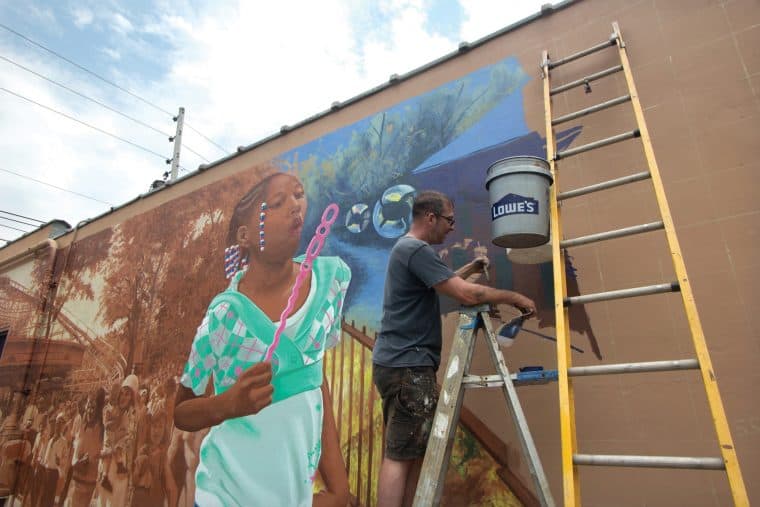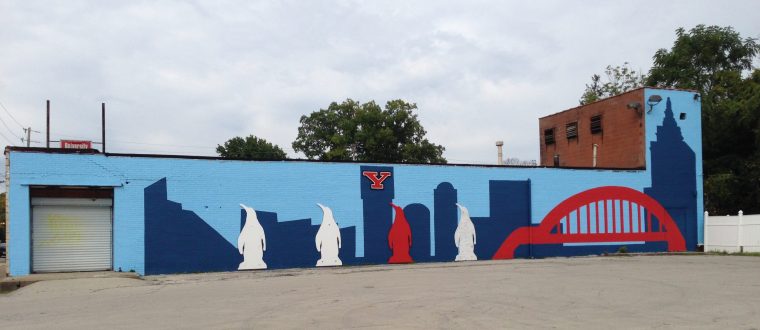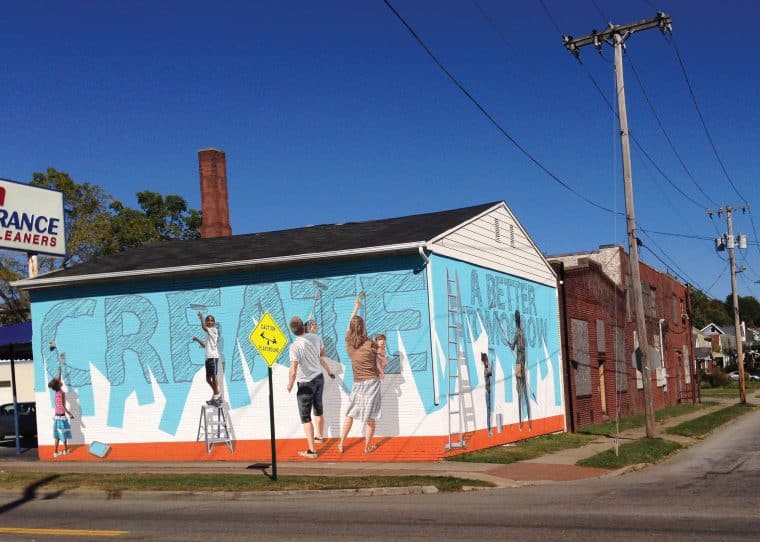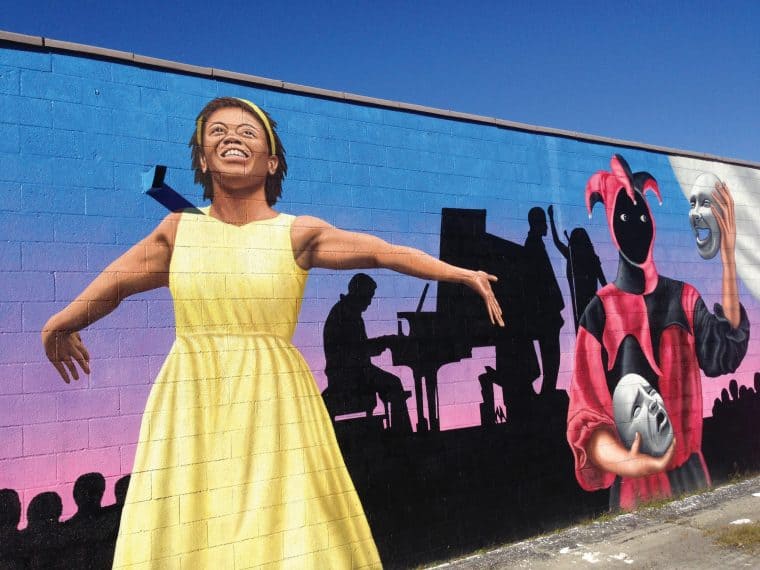Public art brightens neighborhoods, seeks to spur revival | Cities from Omaha to Philadelphia are experiencing a new explosion of visual art in public spaces and now Youngstown is getting in on the act.

Over the past decade, a new era of urban revitalization has brought young professionals, millennials and retirees back to central cities. This influx of residents and tax revenue is helping to bolster faltering neighborhoods and distressed downtowns. Along with this urban renaissance comes a new emphasis on public art.
Many embattled cities in the 1970s looked to pubic art as a way to beautify corridors and help check the spread of graffiti. Today, cities from Omaha to Philadelphia are experiencing a new explosion of visual art in public spaces, and now Youngstown is getting in on the act.
Youngstown’s experience with public art is both recent and occasionally controversial. In 1978, months after the closing of the Sheet and Tube Campbell Works, the Youngstown Area Arts Council commissioned artist George Segal to create a sculpture immortalizing the role of steel in the area’s culture. “The Steelmakers,” a lifelike cast of two local steelworkers and an accompanying model of an open-hearth furnace, made its debut on Federal Plaza in 1980.
The sight of the bronze statues downtown polarized the community. Some saw them as a beautiful memorialization of the city’s industrial heritage; others viewed “The Steelmakers” as an unnecessary reminder of an era Youngstown was struggling to forget. After being vandalized multiple times, the city relocated it in the 1990s to the newly constructed Youngstown Historical Center for Industry and Labor.
During the past few decades, public art has played an increasing role in the expanding campus of Youngstown State University. In 1990, the state established the Ohio Percent for Arts Program. Whenever the legislature earmarks funds totaling $4 million or more for a public building, 1 percent of the total must be allotted for artwork.
Three public art projects have been funded since that time at YSU: an untitled piece by Walter Gordinier at Beeghly Hall; “Inner Circles,” by David Black at Moser Hall; and “Corpus Mirabile,” by Miguel Gomez at the Williamson College of Business in 2011.
Controversy also followed Black’s piece when it appeared on campus. An editorial in The Jambar at the time questioned the use of funds for the project, but the real issue involved confusion over funding.
“That money is earmarked by state law; it doesn’t come out of tuition money,” said Susan Russo, a former art professor at the university.
In addition, several privately funded pieces have been commissioned for the university grounds, including a bronze sculpture of the university’s first president, Howard Jones, and former Penguins coach Dominic Rosselli.
At one time the city’s downtown and commercial corridors glowed with the neon lights of theater marquees. Colorful painted advertisements graced the soot-covered buildings and enormous blade signs greeted window shoppers out for a day on the town. Many of those vestiges of the past are now gone, but a dedicated group of local artists are working to bring new visual life to the downtown.
In 2007, printmaker Jack Carlton and a group of local artists began hanging a series of photomontages on the scarred shell of the Paramount Theater. Consisting of historical photographs from the Mahoning Valley Historical Society, and lithographs of paintings from the permanent collection at the Butler Institute of American Art, the “Museum Without Walls” project is designed to bring public art to the once bustling downtown.
“In 1993, I came back to Youngstown after many years away,” Carlton said. “I went downtown on a Sunday and I couldn’t believe my eyes. ‘My, God! It’s devastated!’ I thought.”
By the time of the city’s bicentennial in 1996, Carlton had convinced a series of local artists to allow him to hang their work over abandoned commercial window spaces downtown. He called it the “Windows Project.”
With the permission and cooperation of the Mahoning Valley Historical Society and the Butler, Carlton expanded the project to include hanging large vinyl photomontages on the side of abandoned storefronts all along West Federal Street.
The project immediately caught on with the public.
“Just being able to put these in windows or on the buildings and see people walk by and talk about them… It was just a delight,” Carlton said.
The subsequent demolition of the Paramount forced Carlton to remove many of the images. However, he plans on expanding the project to new venues downtown in the near future.

In 2010, the Idora Neighborhood Association, in partnership with Art Youngstown, spearheaded the creation of a mural welcoming visitors and passersby to the neighborhood. Painted entirely by residents, it was the first piece of public art to appear on the South Side since Ode Aduma, attempting to show a new spirit of black pride, painted a series of African inspired murals on Hillman Street in the early ‘70s.
Two years later the Youngstown Neighborhood Development Corporation hired Curtis Goldstein, a Columbus-based artist, to paint a mural on the north wall of the former Park Inn on Glenwood Avenue. The earth-toned mural depicts the history of the Idora Park along with portraits of children and residents currently living in the Idora neighborhood.
The executive director of the YNDC, Ian Beniston, views public art as a way to “bring some vibrancy, color and positive energy” to the Glenwood commercial corridor.
In 2014, the YNDC commissioned two artists, Jeremy Jarvis and Tommy Morgan, to paint two more murals—one on the side of La France Dry cleaners on Glenwood and the other on the southern wall of the former Park Inn.
YNDC drew inspiration for sponsoring the projects from the Philadelphia Mural Arts Program—the largest of its kind in the nation.
“I think there’s potential to do it all over the city,” Beniston said. “The arts are going to be a critical component of some corridors of the city if they are going to have a productive future.”
In 2012, local artist Christian Mrosko painted the first of a two-part mural on a building near the Youngstown Playhouse. The project, done in coordination with the Playhouse and YNDC, aimed to not only beautify part of the Glenwood corridor, but also to promote local theater and the diversity of the surrounding neighborhoods.
“Large public art works are important to the development of culture and civilization,” according to Mrosko.
The larger than life images of actors and dancers attracted the interest of Community Corrections Association CEO Richard Billak, who commissioned Mrosko to paint a mural on the Larew Building near the Market Street Bridge.
The colorful mural depicts the vibrant nature of downtown nightlife.
Mrosko would like to see more murals, especially in the central business district. “Having large-scale murals downtown would be particularly stunning. You can walk right up to them; it’s more effective than just driving by.”
After a short and sometimes controversial relationship with public art, Youngstown is slowly but surely expanding venues and opportunities for artists to engage the public. As community development groups grow and the downtown continues to revitalize, it’s likely that the city will continue to enjoy a visual feast of new art.

Metro Monthly is a local news and events magazine based in Youngstown, Ohio. Stay connected with news, features and essential Valley events. We circulate throughout the Mahoning Valley (and beyond) with print, online and flipbook editions. We offer print and website advertising. Office: 330-259-0435.
© 2015 Metro Monthly. All rights reserved.





